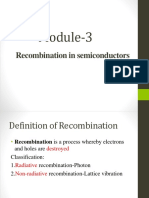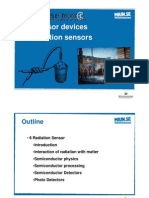Modulation
Uploaded by
Biswarup MukherjeeModulation
Uploaded by
Biswarup Mukherjee8.
Optical Modulation
Modulation Techniques
Direct modulation of laser diode
Vary the current supply to the laser diode
Directly modulates the output power of the laser
External modulation
Change the transmission characteristics
Change the power of a continuous wave laser
Rate Equations of Laser Diodes
The semiconductor laser is essentially a two-level laser
Light emission based on two coupled rate equations
The carrier density of excited electrons (N)
The photon density (N
ph
)
Carrier Density Rate Equation
v
g
: group velocity L: confinement factor
a: gain constant q
g
: gain suppression coef.
( )
( )
emission
stimulated
emission
s spontaneou
2
ion recombinat
ve nonradiati
inj ection
current
rate
carrier
ph g
nr
N N g v N B
N
d q
t J
dt
dN
I =
t
( ) ( )
o
N N a N g =
ph g
o
N
a
a
q +
=
1
Photon Density Rate Equation
|
sp
: percentage of spontaneous emission coherent and in phase with
stimulated emission (~10E-5)
t
sp
: photon decay constant
o
tot
: total cavity loss
( )
emission stimulated
emission
s spontaneou
2
photons
of loss
rate Photon
ph g sp
ph
ph ph
N N g v N B
N
dt
dN
I = |
t
tot g sp
v o t = 1
Steady State Solution
Steady state requires the carrier density and the photon density to b
constant
The photon density rate equation yields
N
ph
must be positive which requires
0 = =
dt
dN
dt
dN
ph
( ) N g v
N B
N
g ph
sp
ph
I
=
t
|
1
2
( )
ph g
N g v t 1 < I
Threshold Condition
The carrier threshold condition is where
Since the gain is also given by
Resulting in a threshold carrier density of
The photon density then becomes
( )
ph th g
N g v t 1 = I
a
N N
tot
o th
I
+ =
o
( ) ( )
o th th
N N a N g =
( )
g ph
th
v
N g
I
=
t
1
( ) N N a v
N B
N
th g
sp
ph
I
=
2
|
Steady State
This means that in steady state N
th
>N
High photon flux occurs when N~N
th
With N~N
th
Resulting in
The total power is
(
(
+ + =
ph
ph
th
nr
th
N
N B
N
qd J
t t
2
( )
th
ph
ph
J J
d q
N =
t
( )
th nr th th
N B N d q J + = t 1
| |
( )( )
th
tot
I I R
m L
P
|
|
.
|
\
| I
= 1
24 . 1
2 o
DC Laser Diode Response
Initial Photon Density
Rate of increase of photon density (dN
ph
/dt) is essentially zero when
N
ph
is small
It will not become significant until the net gain is positive
This is equivalent to
When the laser diode is initially turned on the photon density stays
essentially zero until N reached N
th
( )
I
>
o
N g
th
N N >
( )
ph g sp
ph
ph ph
N N g v N B
N
dt
dN
I =
2
|
t
Initial Carrier Density
Rate of increase of N (dN/dt) is positive when N
ph
is small
Causing an increase in the carrier density
2
BN
N
d q
J
dt
dN
nr
~
t
Exceeding Threshold
When N>N
th
Optical gain becomes positive
Photon density increases rapidly
Exceeds the steady state value
The increase in N
ph
causes
decrease in the dN/dt because of
the stimulated emission term is
negative
When N
ph
reaches a certain value
dN/dt becomes negative
N starts to decrease
( )
ph g
N N g v I
Relaxation Oscillations
When N drops below N
th
N starts increasing again
The process repeats itself as a damped oscillation
N stays very close to N
th
Final Pulse Response
When the laser turns off
N decreases
When N<N
th
the photon density drops to essentially zero
You might also like
- Introduction To Laser Theory: John Suárez Princeton REU Program Summer 2003No ratings yetIntroduction To Laser Theory: John Suárez Princeton REU Program Summer 200325 pages
- Module-3: Recombination in SemiconductorsNo ratings yetModule-3: Recombination in Semiconductors13 pages
- Applications: Chemical and Phase Equilibria: 5.60 Spring 2008 Lecture #29No ratings yetApplications: Chemical and Phase Equilibria: 5.60 Spring 2008 Lecture #296 pages
- Simple and Physical Pendula Simple Pendulum: "Point" Mass M On Massless String LNo ratings yetSimple and Physical Pendula Simple Pendulum: "Point" Mass M On Massless String L11 pages
- Effect of Noise On Analog Communication Systems50% (2)Effect of Noise On Analog Communication Systems106 pages
- An Introduction To Optical Amplifiers: OutlineNo ratings yetAn Introduction To Optical Amplifiers: Outline8 pages
- Introduction To Laser Doppler VelocimetryNo ratings yetIntroduction To Laser Doppler Velocimetry30 pages
- Diode Operation: 97.398, Physical Electronics, Lecture 8No ratings yetDiode Operation: 97.398, Physical Electronics, Lecture 821 pages
- iXBlue Analog Modulators, Drivers and ModBoxNo ratings yetiXBlue Analog Modulators, Drivers and ModBox33 pages
- Frequency Analysis of Discrete-Time Signals (4.2.1-4.2.3,4.2.5)No ratings yetFrequency Analysis of Discrete-Time Signals (4.2.1-4.2.3,4.2.5)30 pages
- Nonlinear Optical Phenomena Second Harmonic GenerationNo ratings yetNonlinear Optical Phenomena Second Harmonic Generation17 pages
- Radiopropagazione Ed Impatto Ambientale: ArraysNo ratings yetRadiopropagazione Ed Impatto Ambientale: Arrays13 pages
- Sensor Devices Sensor Devices Radiation SensorsNo ratings yetSensor Devices Sensor Devices Radiation Sensors53 pages
- Response of Linear SDOF Systems To Harmonic ExcitationNo ratings yetResponse of Linear SDOF Systems To Harmonic Excitation20 pages
- Laser Amplifier: Spontaneous Emission AbsorptionNo ratings yetLaser Amplifier: Spontaneous Emission Absorption11 pages
- Feynman Lectures Simplified 2C: Electromagnetism: in Relativity & in Dense MatterFrom EverandFeynman Lectures Simplified 2C: Electromagnetism: in Relativity & in Dense MatterNo ratings yet
- Feynman Lectures Simplified 2B: Magnetism & ElectrodynamicsFrom EverandFeynman Lectures Simplified 2B: Magnetism & ElectrodynamicsNo ratings yet
- Introduction To Optical Links: Stavros IezekielNo ratings yetIntroduction To Optical Links: Stavros Iezekiel26 pages
- Signal Degradation in Optical Fibres - Attenuation, Dispersion and Their System ImpactNo ratings yetSignal Degradation in Optical Fibres - Attenuation, Dispersion and Their System Impact32 pages
- EC703B Group Velocity and Phase VelocityNo ratings yetEC703B Group Velocity and Phase Velocity18 pages
- Loss and Bandwidth Definitions: Optical & ElectricalNo ratings yetLoss and Bandwidth Definitions: Optical & Electrical8 pages
- Fiber-Optic Communication Systems An Introduction: Xavier Fernando Ryerson UniversityNo ratings yetFiber-Optic Communication Systems An Introduction: Xavier Fernando Ryerson University36 pages
- Optical Fiber Communication: 06EC72 Seventh Semester D.E. Degree Examination, December 2010No ratings yetOptical Fiber Communication: 06EC72 Seventh Semester D.E. Degree Examination, December 201010 pages
- How To Record A Guitar Track Using Adobe Audition 1No ratings yetHow To Record A Guitar Track Using Adobe Audition 110 pages
- Class D: Tabletop Exercise For Fire IncidentsNo ratings yetClass D: Tabletop Exercise For Fire Incidents8 pages
- Fundamentals of The Mechanics of Conscious Creation by Mohsen Paul Sarfarazi, Ph.D. - Multidimensional ConsciousnessNo ratings yetFundamentals of The Mechanics of Conscious Creation by Mohsen Paul Sarfarazi, Ph.D. - Multidimensional Consciousness18 pages
- Span Tables For Joists and Rafters From AWC in 2015No ratings yetSpan Tables For Joists and Rafters From AWC in 201552 pages
- Electronic Resources As Part of Resources in The LibrariesNo ratings yetElectronic Resources As Part of Resources in The Libraries2 pages
- Leap Scholar - IELTS Speaking TOPICS - 2021 (V2) Part 1 and Part 2No ratings yetLeap Scholar - IELTS Speaking TOPICS - 2021 (V2) Part 1 and Part 223 pages
- 02 Task Performance 1 - ARG GROUP-5-fundaNo ratings yet02 Task Performance 1 - ARG GROUP-5-funda5 pages
- Pierrot Lunaire and The Resistance To Theory100% (1)Pierrot Lunaire and The Resistance To Theory6 pages
- Master in Theoretical and Practical Application of FEM and CAE SimulationNo ratings yetMaster in Theoretical and Practical Application of FEM and CAE Simulation20 pages
- Letter To Lori Swanson Minnesota AG Concerning Open Records Requests To U of MinnesotaNo ratings yetLetter To Lori Swanson Minnesota AG Concerning Open Records Requests To U of Minnesota2 pages
- Power Systems For The 21st Century - H Gas Turbine Combined Cycles GER3935bNo ratings yetPower Systems For The 21st Century - H Gas Turbine Combined Cycles GER3935b22 pages
- Physics: Laminated QuickStudy Reference GuideFrom EverandPhysics: Laminated QuickStudy Reference Guide
- Introduction To Laser Theory: John Suárez Princeton REU Program Summer 2003Introduction To Laser Theory: John Suárez Princeton REU Program Summer 2003
- Applications: Chemical and Phase Equilibria: 5.60 Spring 2008 Lecture #29Applications: Chemical and Phase Equilibria: 5.60 Spring 2008 Lecture #29
- Simple and Physical Pendula Simple Pendulum: "Point" Mass M On Massless String LSimple and Physical Pendula Simple Pendulum: "Point" Mass M On Massless String L
- Diode Operation: 97.398, Physical Electronics, Lecture 8Diode Operation: 97.398, Physical Electronics, Lecture 8
- Frequency Analysis of Discrete-Time Signals (4.2.1-4.2.3,4.2.5)Frequency Analysis of Discrete-Time Signals (4.2.1-4.2.3,4.2.5)
- Nonlinear Optical Phenomena Second Harmonic GenerationNonlinear Optical Phenomena Second Harmonic Generation
- Response of Linear SDOF Systems To Harmonic ExcitationResponse of Linear SDOF Systems To Harmonic Excitation
- Feynman Lectures Simplified 2C: Electromagnetism: in Relativity & in Dense MatterFrom EverandFeynman Lectures Simplified 2C: Electromagnetism: in Relativity & in Dense Matter
- Feynman Lectures Simplified 2B: Magnetism & ElectrodynamicsFrom EverandFeynman Lectures Simplified 2B: Magnetism & Electrodynamics
- Signal Degradation in Optical Fibres - Attenuation, Dispersion and Their System ImpactSignal Degradation in Optical Fibres - Attenuation, Dispersion and Their System Impact
- Loss and Bandwidth Definitions: Optical & ElectricalLoss and Bandwidth Definitions: Optical & Electrical
- Fiber-Optic Communication Systems An Introduction: Xavier Fernando Ryerson UniversityFiber-Optic Communication Systems An Introduction: Xavier Fernando Ryerson University
- Optical Fiber Communication: 06EC72 Seventh Semester D.E. Degree Examination, December 2010Optical Fiber Communication: 06EC72 Seventh Semester D.E. Degree Examination, December 2010
- How To Record A Guitar Track Using Adobe Audition 1How To Record A Guitar Track Using Adobe Audition 1
- Fundamentals of The Mechanics of Conscious Creation by Mohsen Paul Sarfarazi, Ph.D. - Multidimensional ConsciousnessFundamentals of The Mechanics of Conscious Creation by Mohsen Paul Sarfarazi, Ph.D. - Multidimensional Consciousness
- Span Tables For Joists and Rafters From AWC in 2015Span Tables For Joists and Rafters From AWC in 2015
- Electronic Resources As Part of Resources in The LibrariesElectronic Resources As Part of Resources in The Libraries
- Leap Scholar - IELTS Speaking TOPICS - 2021 (V2) Part 1 and Part 2Leap Scholar - IELTS Speaking TOPICS - 2021 (V2) Part 1 and Part 2
- Master in Theoretical and Practical Application of FEM and CAE SimulationMaster in Theoretical and Practical Application of FEM and CAE Simulation
- Letter To Lori Swanson Minnesota AG Concerning Open Records Requests To U of MinnesotaLetter To Lori Swanson Minnesota AG Concerning Open Records Requests To U of Minnesota
- Power Systems For The 21st Century - H Gas Turbine Combined Cycles GER3935bPower Systems For The 21st Century - H Gas Turbine Combined Cycles GER3935b









































































































